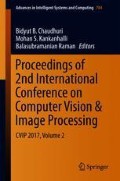Abstract
In this work, we look to address the problem of temporal segmentation of human activity for videos captured with depth cameras. We propose a novel feature definition (namely, joint angle variance (JAV)) which works with skeleton joint data from depth videos. We define the angle between nearby joints as joint angles and compute the variance of each of these joint angles over a set of frames. The variance values for all the joint angles are concatenated to form the feature vector for that particular window of frames. We then use these feature vectors to train a support vector machine (SVM). Given a new test sequence, we can classify each frame belonging to a particular class by computing the class probabilities of the JAV feature computed from its corresponding window. We demonstrate the efficacy of our approach on a standard dataset consisting of ten different actions. Our work highlights that a rather simplistic and efficient formulation can also yield a good temporal segmentation performance on RGBD data.
Access this chapter
Tax calculation will be finalised at checkout
Purchases are for personal use only
References
D. Jardim, L. Nunes, and M. Sales Dias, Automatic human activity segmentation and labeling in RGBD videos, Intelligent Decision Technologies, 2016.
I. Lillo, J. Niebles, and A. Soto, A hierarchical pose-based approach to complex action understanding using dictionaries of actionlets and motion poselets, IEEE Conference on Computer Vision and Pattern Recognition (CVPR), 2016.
J. Sung, C. Ponce, B, Selman, and A. Saxena Unstructured human activity detection from RGBD images, IEEE International Conference on Robotics and Automation, 2012.
M. Devanne S. Berretti, P. Pala, H. Wannous, M. Daoudi, and A. Del Bimbo, Motion segment decomposition of RGBD sequences for human behavior understanding Pattern Recognition, vol. 61, 2017, pp. 222–233.
F. Ofli, R. Chaudhry, G. Kurillo, R. Vidal, and R. Bajcsy, Sequence of the most informative joints (SMIJ): A new representation for human skeletal action recognition, IEEE Conference on Computer Vision and Pattern Recognition Workshops (CVPRW), 2012.
R. Vemulapalli, F. Arrate, and R. Chellappa, Human action recognition by representing 3d skeletons as points in a lie group, IEEE Conference on Computer Vision and Pattern Recognition (CVPR), 2014.
O. Oreifej and Z. Liu, Hon4d: Histogram of oriented 4d normals for activity recognition from depth sequences, IEEE Conference on Computer Vision and Pattern Recognition (CVPR), 2013.
C. Chen, K. Liu, and N. Kehtarnavaz, Real-time human action recognition based on depth motion maps, Journal of Real-Time Image Processing, vol. 12, no. 1, 2016, pp. 155–163.
J. Wang, Z. Liu, Y. Wu, and J. Yuan, Mining actionlet ensemble for action recognition with depth cameras, IEEE Conference on Computer Vision and Pattern Recognition (CVPR), 2012.
E. Cippitelli, S. Gasparrini, E. Gambi, and S. Spinsante, A human activity recognition system using skeleton data from RGBD sensors, Computational Intelligence and Neuroscience, vol. 2016, 2016, pp. 1–14.
Y. Poleg, C. Arora, and S. Peleg, Temporal segmentation of egocentric videos, IEEE Conference on Computer Vision and Pattern Recognition (CVPR), 2014.
E. Spriggs, F. De La Torre, and M. Hebert Temporal segmentation and activity classification from first-person sensing, IEEE Conference on Computer Vision and Pattern Recognition Workshops (CVPRW), 2009.
M. Hoai, Z. Lan, and F. De la Torre, Joint segmentation and classification of human actions in video, IEEE Conference on Computer Vision and Pattern Recognition (CVPR), 2011.
S. Ma, L. Sigal, and S. Sclaroff, Learning activity progression in LSTMs for activity detection and early detection, IEEE Conference on Computer Vision and Pattern Recognition (CVPR), 2016.
V. Bloom, V. Argyriou, and D. Makris, Dynamic feature selection for online action recognition, Int. Workshop on Human Behavior Understanding, Springer, 2013.
A. Sharaf, M. Torki, M. E. Hussein, and M. El-Saban, Real-time multi-scale action detection from 3d skeleton data, IEEE Winter Conference on Applications of Computer Vision (WACV), 2015.
L. Xia, C. Chen, and J. Aggarwal, View invariant human action recognition using histograms of 3d joints, IEEE Computer Vision and Pattern Recognition Workshops (CVPRW), 2012.
C. Chang and C. Lin, LIBSVM: A library for support vector machines, ACM Transactions on Intelligent Systems and Technology, vol. 2, no. 3, 2011, pp. 1–27.
T. Wu, C. Lin, R. Weng, Probability estimates for multi-class classification by pairwise Coupling, Journal of Machine Learning Research, vol. 5, 2004, pp. 975–1005.
Author information
Authors and Affiliations
Corresponding author
Editor information
Editors and Affiliations
Rights and permissions
Copyright information
© 2018 Springer Nature Singapore Pte Ltd.
About this paper
Cite this paper
Jafar, S., Singh, P.K., Bhavsar, A. (2018). Temporal Activity Segmentation for Depth Cameras Using Joint Angle Variance Features. In: Chaudhuri, B., Kankanhalli, M., Raman, B. (eds) Proceedings of 2nd International Conference on Computer Vision & Image Processing . Advances in Intelligent Systems and Computing, vol 704. Springer, Singapore. https://doi.org/10.1007/978-981-10-7898-9_28
Download citation
DOI: https://doi.org/10.1007/978-981-10-7898-9_28
Published:
Publisher Name: Springer, Singapore
Print ISBN: 978-981-10-7897-2
Online ISBN: 978-981-10-7898-9
eBook Packages: EngineeringEngineering (R0)

